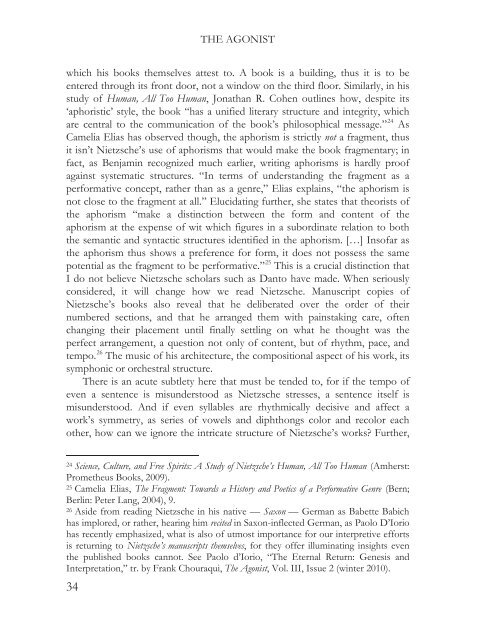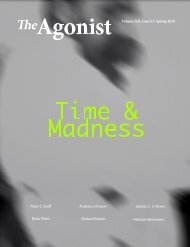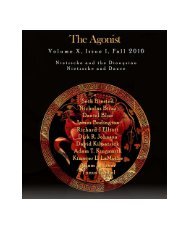Volume XI, Issue II, Spring 2018
You also want an ePaper? Increase the reach of your titles
YUMPU automatically turns print PDFs into web optimized ePapers that Google loves.
THE AGONIST<br />
which his books themselves attest to. A book is a building, thus it is to be<br />
entered through its front door, not a window on the third floor. Similarly, in his<br />
study of Human, All Too Human, Jonathan R. Cohen outlines how, despite its<br />
‘aphoristic’ style, the book “has a unified literary structure and integrity, which<br />
are central to the communication of the book’s philosophical message.” 24 As<br />
Camelia Elias has observed though, the aphorism is strictly not a fragment, thus<br />
it isn’t Nietzsche’s use of aphorisms that would make the book fragmentary; in<br />
fact, as Benjamin recognized much earlier, writing aphorisms is hardly proof<br />
against systematic structures. “In terms of understanding the fragment as a<br />
performative concept, rather than as a genre,” Elias explains, “the aphorism is<br />
not close to the fragment at all.” Elucidating further, she states that theorists of<br />
the aphorism “make a distinction between the form and content of the<br />
aphorism at the expense of wit which figures in a subordinate relation to both<br />
the semantic and syntactic structures identified in the aphorism. […] Insofar as<br />
the aphorism thus shows a preference for form, it does not possess the same<br />
potential as the fragment to be performative.” 25 This is a crucial distinction that<br />
I do not believe Nietzsche scholars such as Danto have made. When seriously<br />
considered, it will change how we read Nietzsche. Manuscript copies of<br />
Nietzsche’s books also reveal that he deliberated over the order of their<br />
numbered sections, and that he arranged them with painstaking care, often<br />
changing their placement until finally settling on what he thought was the<br />
perfect arrangement, a question not only of content, but of rhythm, pace, and<br />
tempo. 26 The music of his architecture, the compositional aspect of his work, its<br />
symphonic or orchestral structure.<br />
There is an acute subtlety here that must be tended to, for if the tempo of<br />
even a sentence is misunderstood as Nietzsche stresses, a sentence itself is<br />
misunderstood. And if even syllables are rhythmically decisive and affect a<br />
work’s symmetry, as series of vowels and diphthongs color and recolor each<br />
other, how can we ignore the intricate structure of Nietzsche’s works? Further,<br />
24 Science, Culture, and Free Spirits: A Study of Nietzsche’s Human, All Too Human (Amherst:<br />
Prometheus Books, 2009).<br />
25 Camelia Elias, The Fragment: Towards a History and Poetics of a Performative Genre (Bern;<br />
Berlin: Peter Lang, 2004), 9.<br />
26 Aside from reading Nietzsche in his native — Saxon — German as Babette Babich<br />
has implored, or rather, hearing him recited in Saxon-inflected German, as Paolo D’Iorio<br />
has recently emphasized, what is also of utmost importance for our interpretive efforts<br />
is returning to Nietzsche’s manuscripts themselves, for they offer illuminating insights even<br />
the published books cannot. See Paolo d’Iorio, “The Eternal Return: Genesis and<br />
Interpretation,” tr. by Frank Chouraqui, The Agonist, Vol. <strong>II</strong>I, <strong>Issue</strong> 2 (winter 2010).<br />
34









